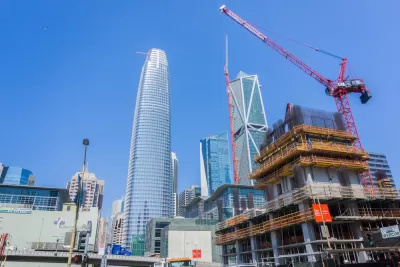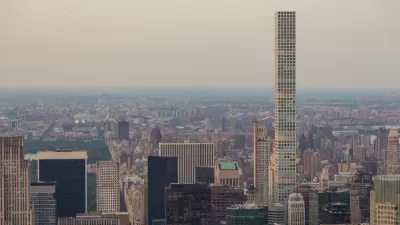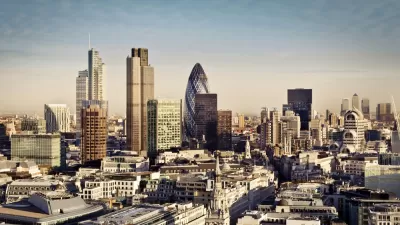Of the city’s newest, tallest building John King writes, “[it’s] as if the creators were so busy being tasteful they forgot that big buildings can be fun."

This week, the Salesforce Tower in San Francisco “quietly opened for business,” and John King, architecture critic for the San Francisco Chronicle, is only very mildly impressed.
“The 1,070-foot shaft, with its tapered form of metal and glass, is a well-tailored behemoth. Immense but understated. Overwhelming yet refined. A study in thick-walled minimalism that seems to hover more than soar.
All of which makes for a nuanced tower, conscientious and self-assured even as it reorients the skyline and redefines San Francisco’s visual image. But there’s also an air of detachment, as if the creators were so busy being tasteful they forgot that big buildings can be fun.”
In its many years under construction, the Salesforce Tower easily surpassed the height of San Francisco's now-second-tallest building, the TransAmerica Pyramid. That building was controversial in its own time but, as King previously wrote, has an iconic quality that is arguably lacking in the city's newest skyscraper.
One of a new crop of very tall buildings on the West Coast, naming rights to the Salesforce Tower—originally known as the Transbay Tower—were bought by a cloud-computing company that is a major employer in San Francisco and agreed to lease 36 of the available 61 floors.
The symbolism of a tech company looming over the entire city is not lost on observers, King has reported. And buildings of increasing heights have long been used to establish dominance in San Francisco, David Streitfeld recently wrote in The New York Times, adding of the Salesforce building, “The tower is not beautiful but is impossible to ignore.”
King reports similarly tempered comments from one of the principle architects, Cesar Pelli, who said of the tower that its was meant to be “very tall, very big, but still polite.’”
FULL STORY: Salesforce Tower - underwhelming despite its size

Maui's Vacation Rental Debate Turns Ugly
Verbal attacks, misinformation campaigns and fistfights plague a high-stakes debate to convert thousands of vacation rentals into long-term housing.

Planetizen Federal Action Tracker
A weekly monitor of how Trump’s orders and actions are impacting planners and planning in America.

In Urban Planning, AI Prompting Could be the New Design Thinking
Creativity has long been key to great urban design. What if we see AI as our new creative partner?

King County Supportive Housing Program Offers Hope for Unhoused Residents
The county is taking a ‘Housing First’ approach that prioritizes getting people into housing, then offering wraparound supportive services.

Researchers Use AI to Get Clearer Picture of US Housing
Analysts are using artificial intelligence to supercharge their research by allowing them to comb through data faster. Though these AI tools can be error prone, they save time and housing researchers are optimistic about the future.

Making Shared Micromobility More Inclusive
Cities and shared mobility system operators can do more to include people with disabilities in planning and operations, per a new report.
Urban Design for Planners 1: Software Tools
This six-course series explores essential urban design concepts using open source software and equips planners with the tools they need to participate fully in the urban design process.
Planning for Universal Design
Learn the tools for implementing Universal Design in planning regulations.
planning NEXT
Appalachian Highlands Housing Partners
Mpact (founded as Rail~Volution)
City of Camden Redevelopment Agency
City of Astoria
City of Portland
City of Laramie




























